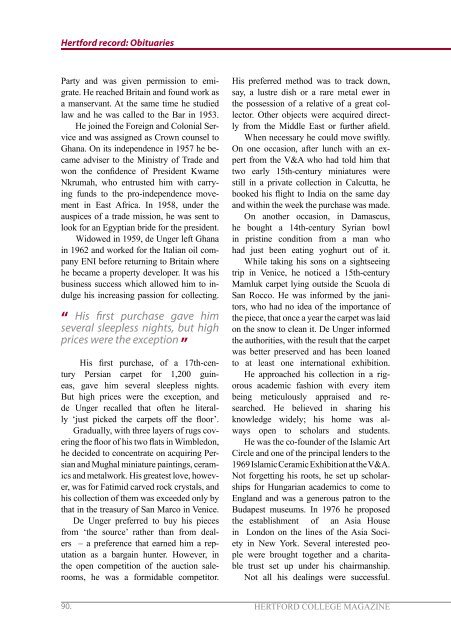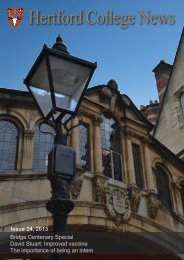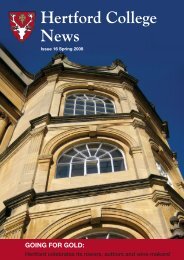2011 Hertford College Magazine (Issue 91)
2011 Hertford College Magazine (Issue 91)
2011 Hertford College Magazine (Issue 91)
Create successful ePaper yourself
Turn your PDF publications into a flip-book with our unique Google optimized e-Paper software.
<strong>Hertford</strong> record: Obituaries<br />
Party and was given permission to emigrate.<br />
He reached Britain and found work as<br />
a manservant. At the same time he studied<br />
law and he was called to the Bar in 1953.<br />
He joined the Foreign and Colonial Service<br />
and was assigned as Crown counsel to<br />
Ghana. On its independence in 1957 he became<br />
adviser to the Ministry of Trade and<br />
won the confidence of President Kwame<br />
Nkrumah, who entrusted him with carrying<br />
funds to the pro-independence movement<br />
in East Africa. In 1958, under the<br />
auspices of a trade mission, he was sent to<br />
look for an Egyptian bride for the president.<br />
Widowed in 1959, de Unger left Ghana<br />
in 1962 and worked for the Italian oil company<br />
ENI before returning to Britain where<br />
he became a property developer. It was his<br />
business success which allowed him to indulge<br />
his increasing passion for collecting.<br />
“ His first purchase gave him<br />
several sleepless nights, but high<br />
prices were the exception ”<br />
His first purchase, of a 17th-century<br />
Persian carpet for 1,200 guineas,<br />
gave him several sleepless nights.<br />
But high prices were the exception, and<br />
de Unger recalled that often he literally<br />
‘just picked the carpets off the floor’.<br />
Gradually, with three layers of rugs covering<br />
the floor of his two flats in Wimbledon,<br />
he decided to concentrate on acquiring Persian<br />
and Mughal miniature paintings, ceramics<br />
and metalwork. His greatest love, however,<br />
was for Fatimid carved rock crystals, and<br />
his collection of them was exceeded only by<br />
that in the treasury of San Marco in Venice.<br />
De Unger preferred to buy his pieces<br />
from ‘the source’ rather than from dealers<br />
– a preference that earned him a reputation<br />
as a bargain hunter. However, in<br />
the open competition of the auction salerooms,<br />
he was a formidable competitor.<br />
His preferred method was to track down,<br />
say, a lustre dish or a rare metal ewer in<br />
the possession of a relative of a great collector.<br />
Other objects were acquired directly<br />
from the Middle East or further afield.<br />
When necessary he could move swiftly.<br />
On one occasion, after lunch with an expert<br />
from the V&A who had told him that<br />
two early 15th-century miniatures were<br />
still in a private collection in Calcutta, he<br />
booked his flight to India on the same day<br />
and within the week the purchase was made.<br />
On another occasion, in Damascus,<br />
he bought a 14th-century Syrian bowl<br />
in pristine condition from a man who<br />
had just been eating yoghurt out of it.<br />
While taking his sons on a sightseeing<br />
trip in Venice, he noticed a 15th-century<br />
Mamluk carpet lying outside the Scuola di<br />
San Rocco. He was informed by the janitors,<br />
who had no idea of the importance of<br />
the piece, that once a year the carpet was laid<br />
on the snow to clean it. De Unger informed<br />
the authorities, with the result that the carpet<br />
was better preserved and has been loaned<br />
to at least one international exhibition.<br />
He approached his collection in a rigorous<br />
academic fashion with every item<br />
being meticulously appraised and researched.<br />
He believed in sharing his<br />
knowledge widely; his home was always<br />
open to scholars and students.<br />
He was the co-founder of the Islamic Art<br />
Circle and one of the principal lenders to the<br />
1969 Islamic Ceramic Exhibition at the V&A.<br />
Not forgetting his roots, he set up scholarships<br />
for Hungarian academics to come to<br />
England and was a generous patron to the<br />
Budapest museums. In 1976 he proposed<br />
the establishment of an Asia House<br />
in London on the lines of the Asia Society<br />
in New York. Several interested people<br />
were brought together and a charitable<br />
trust set up under his chairmanship.<br />
Not all his dealings were successful.<br />
90. HERTFORD COLLEGE MAGAZINE




